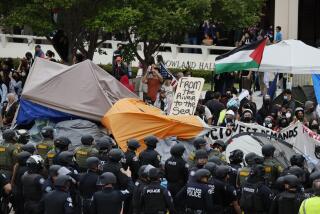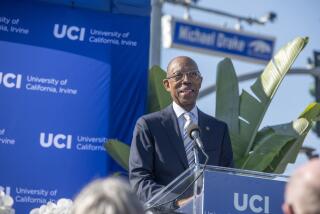UC Davis Will Lead Research on Global Climate Changes
- Share via
SANTA CRUZ — A national center to research global environmental and climate changes will be established at UC Davis, University of California officials announced Thursday.
To be funded with an initial $6-million grant from the U.S Department of Energy, the project is expected to help better understand the causes and consequences of the greenhouse effect and find ways to avoid catastrophic climate changes.
The greenhouse effect is caused by carbon dioxide and other gases that accumulate in the atmosphere. The gases trap heat on Earth much as the panes of a greenhouse absorb sunlight.
The National Institute for Global Environmental Change will be headquartered at UC Davis, although scientists throughout the UC system and at three other universities--Harvard, Indiana and Tulane--will share in the research. The opening date is not yet known.
Each school will specialize in different areas of research. For example, UC will concentrate on atmospheric changes, while Tulane will examine rises in sea level.
The announcement was made at the UC Regents meeting at the Santa Cruz campus.
UC Davis Chancellor Theodore L. Hullar said his campus was chosen because of its track record in environmental research, particularly the work of Marvin Goldman, professor of radiological sciences. An expert in the assessment of cancer risk due to solar and nuclear radiation, Goldman will be a co-director of the institute. Hullar added that Rep. Vic Fazio (D-Sacramento), whose district includes the campus, played a key role in bringing the institute to Davis.
In another matter, a regents’ committee approved a long-range development plan for UC Riverside that would increase student enrollment from the current 8,200 to 18,050 over the next 15 years. Approval by the full Board of Regents is expected today.
Under the plan, the amount of classroom, dormitory, lab and office space would triple, at an estimated cost of more than $550 million. Most of the new construction would take place on the east side of the 215 Freeway, where almost all of the buildings are now located. However, 108 acres of open land now used for agricultural research on the other side of the freeway would also be given over to housing and classrooms. A pedestrian mall and a new roadway over the freeway would link the two sides of the campus.
Several regents sharply questioned UC Riverside Chancellor Rosemary Schraer over why the plan included proposed establishment of law and medical schools even though the regents have been extremely reluctant to authorize any new such professional programs.
Schraer stressed that the plan was merely a wish list and that every new school and building would require regents’ approval. She insisted, however, that rapid population growth in the Inland Empire would prove the need for law and medical schools at UC Riverside over the next decade.
UC Riverside has had to battle an image as a sleepy, smoggy place compared to more glamorously located campuses such as UC Santa Barbara and UC Berkeley. However, UC Riverside has become more popular in recent years and increasingly is viewed as a safety valve for overall UC growth, especially since enrollments at UCLA and UC Berkeley have been capped.







